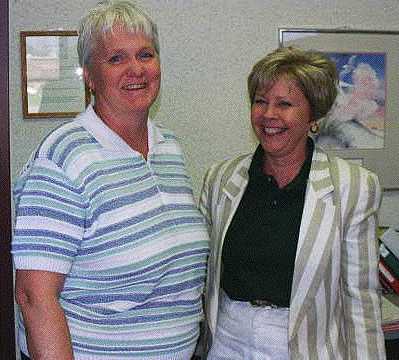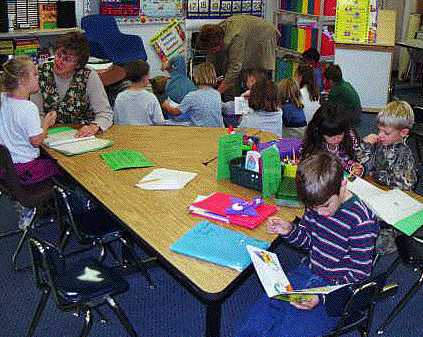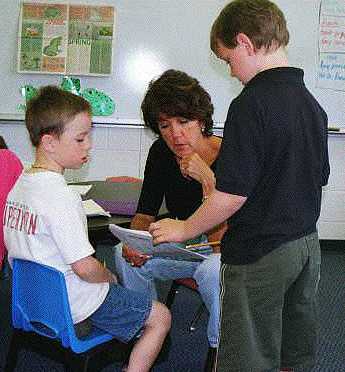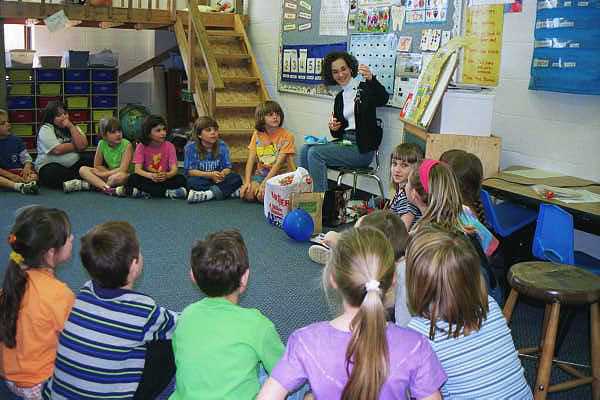Principals: Annette Smith and Pam Barnes

Students: 800 K-5
Ezra
Eby Elementary School
220 West Avenue
P.O. Box 308
Napoleon, MI 49261
517-537-8667
The Community.
This school is located in a small, rural community in Jackson County, located in southeastern Michigan, about one and one half-hours west of Detroit. It has the sense of a charming, small town. At it's center is a stop sign for a crossroads around which are clustered the major businesses and community institutions- churches, city hall, etc. The community is growing rapidly, however, as part of the overall growth of the metropolitan area making demands on the school system.
The School.
Principals: Annette Smith and Pam Barnes
Students: 800 K-5
Ezra Eby Elementary School is part of a small district composed of the middle and high schools. These three schools are located across from one another a 1/4 of a mile from the town's central crossroads. The administration of the school district has new leadership over the last few years. They have been seeking to establish a new sense of accountability in the school system and greater responsiveness to the community.
The district's mission statement: "In partnership with our community, the mission of Napoleon Community School, as a leader in education, is to strive for excellence by providing students with quality, equitable and diverse learning experiences, preparing them to become responsible and productive members of a competitive society."
Ezra Eby's mission statement: "We, the Elementary Staff of Napoleon Community Schools believe that all students can learn. We are committed to providing our students with a positive learning environment designed to foster academic and social growth, individual achievement will be measured through formal and informal assessment. We accept the responsibility to educate our students to become productive learners and contributing members of our school community."
School Change and Improvement:
In recent years, almost the total administrative team of the school district has changed. Many efforts are underway to improve the schools and to develop innovations. They are including these efforts in their NCA accreditation process. The school has not adopted a formal school reform model. However, they are actively trying to use data to align their curriculum and ongoing assessments with the MEAP, the state's standardized testing program. The school team has committed themselves to developing an inclusive educational program and has made significant changes in recent years in that direction, particularly in the upper elementary grades.
Early elementary: K-2
The school building itself is shaped like a large U. The early elementary grades (K-2) are located on one side of the building. Most classes in this wing are multi-age classes across three grades. A paraprofessional is assigned to each class. Most classes join one another in a continuous teaching space where staff and children mix. In each classroom, there is a large classroom space, a partitioned area that can be used as a teacher work area and for one on one or small group work with children. They also use tables just outside the classroom for this purpose.
Upper elementary: 3-5
In the upper elementary grades, classes are traditional graded
classrooms 3, 4, & 5. At each grade level, one or two
classes are designated as a co-taught room where a special education
teacher works with the general education teacher. Co-teachers
sometimes collaborate in teaching the lesson and sometimes work
more with students having special needs as the general education
teacher do es
the lesson.
es
the lesson.
Empowering Citizens in a Democracy.
The school has two co-principals who work together to share decision-making. Teachers have weekly common planning times which allow grade level teams and co-teachers to jointly plan together. There is a very supportive atmosphere in the building. Many teachers are engaged in teaching practices that appear to seek to empower children to take active roles in their own learning. Teachers have latitude in selecting teaching philosophies to some degree though some initiatives are clearly encouraged and pushed by the co-principals. Children are taught the rules of the school. These are presented and discussed by the two co-principals together at the first of the school year in grade level meetings with children and staff in the gym. The approach is positive.
Include All.
This school has a range of students with mild to severe disabilities that include autistic (AI), severe and multiply impaired (SXI), and students with Downs Syndrome. About 8 students go to a center program, which they try to avoid. They try to use the least stigmatizing disability label when this is possible. Several students are officially categorized as speech and language impaired who are also autistic or educable mentally retarded. 4.75% (38 students) of the student body, compared with national average of 10% plus, are classified as eligible for special education.
In K-2 students are included in the general education classes with support from paraprofessionals and a special education co-teacher. Some one on one or small group work for specific targeted skills is done in tables in a workroom or in the hall. This program has been in place for about 8 years.
In grades 3-5 they include students with disabilities in general education and assign special education teachers to co-teach in one to two classes per grade level. They have attempted to keep the number of students with disabilities no larger than 5 in a class of 24. They began this process in recent years because they were concerned about performance of these students.
They have, however, become concerned regarding the large number
of high need kids in grade 3-5 and first considered developing
a pull out special education room. Instead they are developing
a process of clustering these students in their own classes to
receive literacy instruction using a model of direct instruction
that is a successor of the Distar  program.
program.
Paraprofessionals work with students with moderate disabilities on a one to one basis in the building. These children often have a parallel curriculum to the rest of the class.
The school has a mix of socio-economic groups with parents
being largely working
class. There are only a small handful of children of color in
the building.
Authentic Teaching and Adapting for Diverse Learners.
Instructional techniques and strategies seem to run a gamut of constructivist, child-centered approaches to more traditional approaches. Some classes have individual desks arranged in rows. Most, however, have students working at tables in groups of five or so. K-2 teachers are clearly involved in authentic, active learning strategies. They are offering special interest classes for students in the evening as part of a recent new program.
The co-principals are pushing teachers to align their curriculum with the MEAP and to develop ongoing assessments that allow teachers to gauge progress towards objectives of the curriculum that the MEAP purports to measure. They believe that this process is serving to increase accountability of teachers for learning of all students. In addition, they strive to focus on aligning curriculum and using good teaching strategies as a strategy for heightening test scores rather than focussing on the taking of the test itself. The school has shown significant increases in test scores in recent years. Teachers work in teams and utilize a variety of ongoing assessments and running records to track progress of students.
Special education co-teachers and general education teachers work together to facilitate supports to students and curriculum adaptations as needed Speech augmentation devices used throughout the building to enhance the voice of the teacher over classroom noise. They have collected data which they believe shows this effort to have raised achievement and test scores. The school makes a distinction between 'adaptations' for special education students, in which students participate in the general curriculum with supports and adaptations in the curriculum. 'Modifications' involve more significant changes involving parallel curriculum for students in the classroom. They include adaptations for MEAP in the IEP.
Building Community and Supporting Learning-
The school is a very welcoming positive place. Parents are
always there and seem to feel very comfortable. The teachers and
co-principals interact in very positive, genuine, caring ways
with children and parents. The support structures put in place
include multi-age teaching, looping, paraprofessionals, and special
education co-teachers. These assist in developing the sense of
care and support that pervades the school. Wednesdays are set
aside for intensive planning among staff- Common Planning Time.
In the morning substitutes are provided so that special education
teacher co-teachers can meet. One time per month all co-teachers
from all three build ings
meet.
ings
meet.
In lower elementary paraprofessionals and parent volunteers provide multiple supports for individualized assistance to students. There are often numerous adults in classrooms. In upper elementary, two special education teachers work with selected 'inclusion' classrooms. There are also additional programs to provide support for students: a service learning program in which high school students do work in the classrooms with teachers and students; and HOST - a mentoring program in which community volunteers read one on one with children.
Parent Partnerships.
The school is very family friendly. They do family outreach efforts such as parent teacher meetings. However, the co-principals and other staff have consistently indicated a need to improve the degree and type of parent connection and involvement in the school. A strategic planning committee meets monthly to address this and other issues and faculty have mandated community involvement. The school district as a whole has developed written communications for parents and a recent study found high degrees of parent satisfaction in interactions with staff of the school and its programs. The building is used frequently by community groups.
Ezra Eby Elementary School
Statistical Data
Napoleon, Michigan.
The population of about 6,300 has a median household income of $34, 172, and a median family income of $35,865. There are approximately 2261 households of which 1,751 are families and 510 are non-family. Of the families, married couples head 1,464. There are about 2.75 persons per household. *
The racial make-up of Napoleon is predominately white (6,172), but also includes black (49), American Indian, Eskimo, or Aleut (28), Asian or Pacific Islander (13). There are 66 individuals of Hispanic descent. *
The primary occupations are in administrative support/clerical, sales, machine operation, and precision production and services. *
Educational attainment of persons 25 years of age or older breaks down as such: 4.3% have less than a 9th grade education; 20.3% have a 9th -12th grade education without a diploma; 37.7% have earned a diploma or equivalency; 21% have some college education, but no degree; and 16.6% have an associates degree or higher. *
Napoleon Public Schools.
The 1998-99 K-12 district enrollment was 1,694 students.
Special Education Students: The district is home to the following impairments as of December 1, 1998**: 11 educable mental impairments, 4 emotional impairments, 85 learning disabilities, 1 hearing impairment, 18 physical and other health impairments, 2 sever multiple impairments, 61 speech and language impairments, 7 preprimary impairments, and 1autism impairment. This is a total of 190 special needs students.
Ezra Eby Elementary Schools.
Principals: Annette Smith and Pam Barnes
Students: 800 K-5
Annual Operating Expenditure Per Pupil: $3, 103(1996-97); $1,654
(1995-96)*
Average Teacher Salary: $44,368 (1996-97)*
% Free/Reduced Lunch: 19%*
Disabilities: This school has a range of students with mild
to severe disabilities that include autistic (AI), severe and
multiply impaired (SXI), students with Downs Syndrome. About 8
students go to a center program which they try to avoid. Several
of these are at parentÌs request. They also try to use
the least stigmatizing disability label when this is possible.
Several students are officially categorized as speech and language
impaired who are also
autistic or educable mentally retarded. 38 (4.75%) of the student
body compared with national average of 10% plus.
Pupil/Teacher Ratio: 25.2/1*
Total Other Staff: Paraprofessionals are hired with at risk funds particularly to work in the lower elementary grades. As you visit these early grade classrooms it seems as though there are many caring adults around to help.
MEAP/Proficiency Scores: (% satisfactory/proficient)*
1998-99 1997-98 1996-97
4th Math 71.9% 82.1% 48.7%
4th Reading 63.7% 64.1% 38.3%
5th Science 26.6% 25.0% 20.2%
5th Writing 58.3% 51.2% 46.6%
*Source: www.mde.state.mi.us
REFERENCES
United States Census. 1990. http://www. census- www.census.gov
Michigan Department of Education. http://www.mde.state.mi.us/off/sped